[ad_1]
Digital advertising is one of the most powerful ways to launch, grow, or scale any business online.
Period.
It can work for any type of product or service, in any industry, at any size.
What’s so magical about it? Why does it work so well?
Well, for starters, digital advertising gives you a scalable and predictable way to generate the one thing every business needs:
Traffic to your site.
We all need traffic to generate leads, which we need to generate customers, which we need to generate revenue.
Of course, you need a lot more than traffic to succeed. You need a great offer, a desirable product or service, a well-designed website, and so on. But without any traffic, none of those things will matter… because no one will ever actually see them.
And that, dear friends, is where digital advertising comes into play.
But before we get into too much detail, let’s start with the basics and make sure we’re all on the same page.
What is Digital Advertising?
When we say “digital advertising,” we’re referring to paid media buying. It’s the process of spending money to get people’s attention online, so you can hopefully convert them into a new customer.
It may seem like a new development, but the concept has been around for a long time. The only things that have changed are the mediums or channels we use.
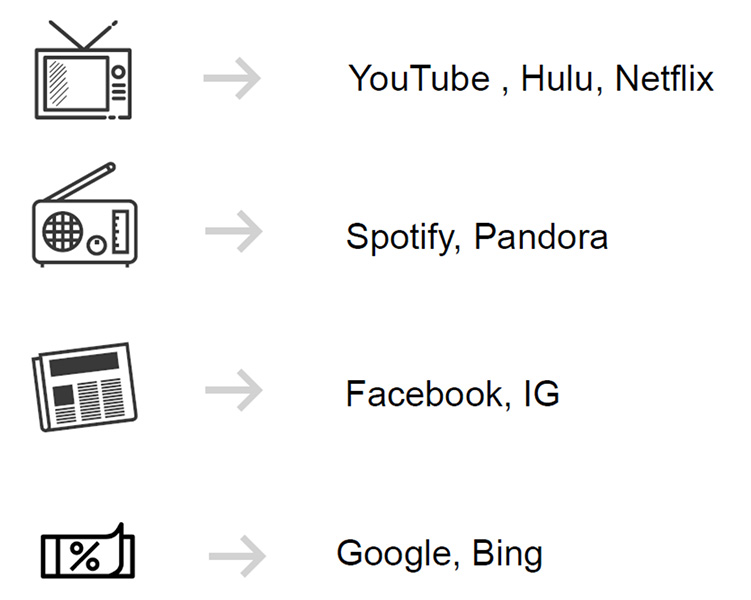
Think of digital advertising like a water hose that sends traffic to your website. The great thing about it is that it’s predictable and completely under your control.
Need more traffic? Just turn the hose on, or turn it up.
Need to pause traffic for a while? Just turn the hose off.
There are a lot of people who complain about the fact that digital advertising costs money. They prefer to get all their traffic through “free” channels like SEO and organic social media.
But there are 3 serious problems with that “organic only” approach:
- First of all, getting organic traffic requires a lot of work… so it’s not really free, is it?
- Second, your traffic depends on the Google/Facebook algorithm… which can change at any time and decimate your traffic if you happen to be on the wrong side of an update
- Finally, you have no control over your traffic and less chance to scale than by adding paid traffic
Regarding point #1: There’s no such thing as a free lunch, or free traffic. You pay for it with either time or money.
Regarding point #2: Did you know that the average organic reach for a Facebook post, as of Q3 2019, was just 5.5%? That means for every 1,000 people that like your page, only 55 will see your organic posts.
Companies like Facebook and Google make their money from ad revenue, which means they have a vested interest in shifting more of their exposure to paid traffic.
Regarding point #3: If paid advertising is like a hose, organic traffic is like the rain. Yes, it’s “free,” but it’s unpredictable. You can’t control it, and you can’t rely on it. Because you might just find yourself in the middle of a drought at the worst possible time.
We’re not saying you shouldn’t try to get organic traffic. Heck, we love organic traffic!
But for anyone who’s serious about launching and growing a real business online, you need more than organic traffic. You need to master paid digital advertising.
And that starts with understanding the big picture.
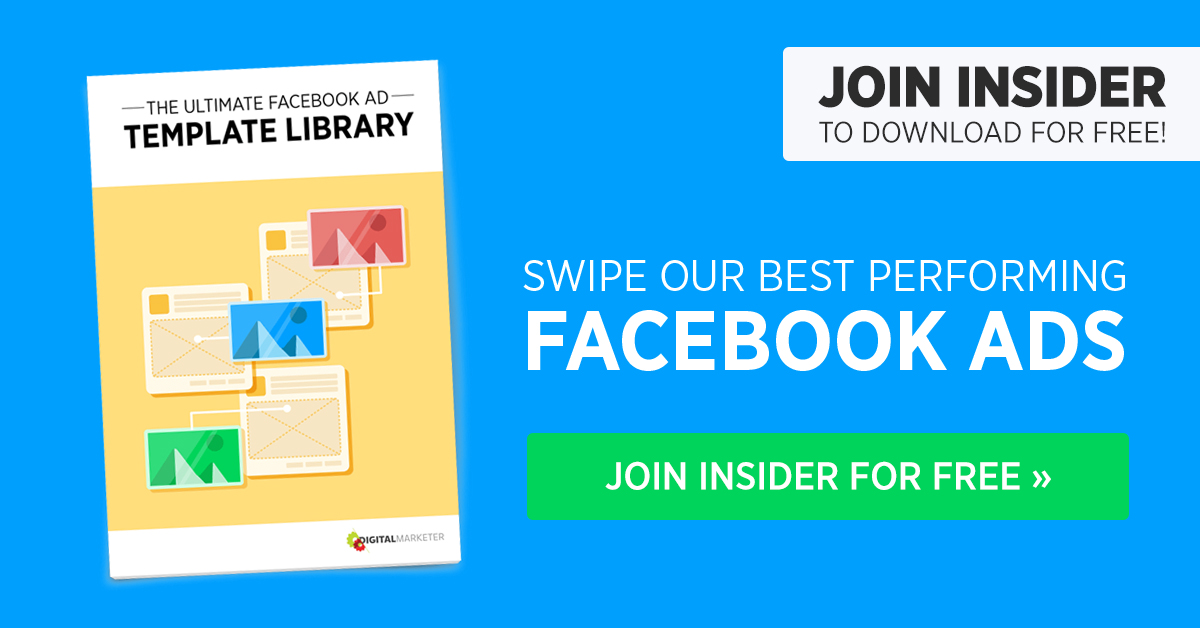
How Digital Advertising Fits in with the Customer Value Journey
Ryan Deiss, the fearless founder of DigitalMarketer, has said:
“The role of marketing is to move prospects and customers seamlessly and subtly through each stage of the Value Journey.”
We love this quote and use it often. We say it so much that if we had an office parrot, it would be repeating this phrase over and over while getting cracker crumbs all over the floor.
Why is this concept so important to remember?
Because it reminds us that even though this is digital advertising, we can’t forget the human element that’s inherent in all of marketing.
Yes, we may be setting up ads inside of digital platforms and manipulating them through technical settings.
But at the end of the day, the person seeing those ads is a human being. And none of this digital marketing stuff is going to work if you don’t understand the person on the other side of the computer screen, what their problems are, what they want, and what process they go through in deciding whether or not to buy.
We mapped this process out for you, and we call it the Customer Value Journey (CVJ for short):

Digital advertising is so versatile that it can potentially be used at ANY stage of the CVJ. But most often, it’s used at these 5 stages: Aware, Engage, Subscribe, Convert, and Ascend.
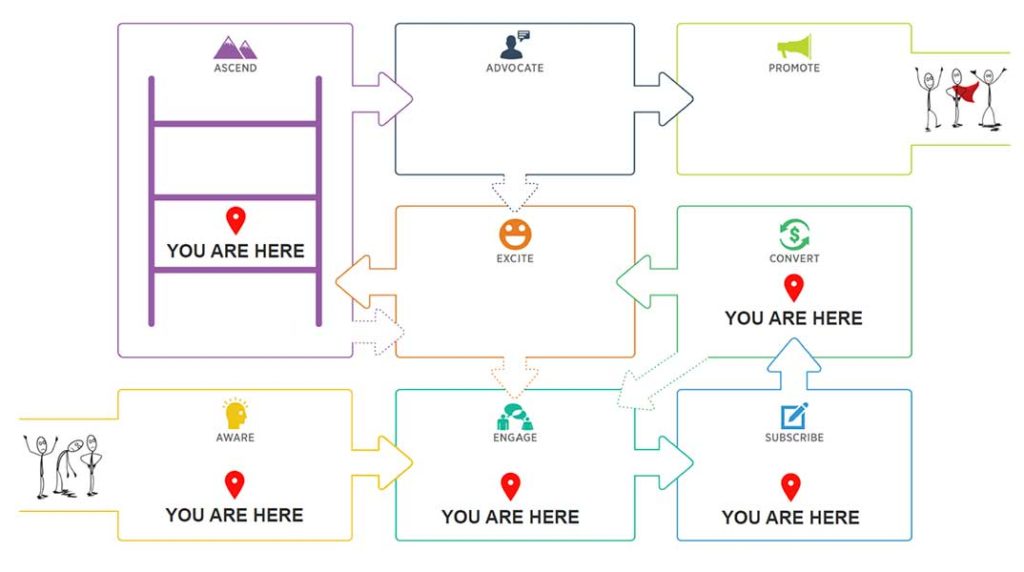
Here are some examples of paid online advertising used at these stages of the CVJ:
Aware
At the very beginning of the CVJ, you’re showing an ad to someone who has never heard of you before. Then, once they see your ad, they have become aware of you.
Here’s an example. If you’d never heard of thredUP before, this Facebook ad would do a good job of catching your attention (notice the bright pink bar that stands out in the newsfeed) and making you aware:

You wouldn’t know much about the company at this point, but you’d know they exist, and you’d know they’re “not your typical thrift store.” That’s all you need to reach step 1 of the CVJ.
Engage
In the next stage in the CVJ, your aim is to get people to interact with you—by reading a blog post, watching a video, commenting on a post, and so on.
Here’s an example of how BookBub does this with the help of a Facebook ad promoting a quiz that generates book recommendations:

Online quizzes are a great way to generate engagement, because they’re quick and easy to complete, and they give you some piece of fun or helpful information.
(In this case, anyone who reads a lot would be interested in new book recommendations based on their preferences.)
Subscribe
Your next goal is to get the person to subscribe—to give you their contact information so you can continue to follow up with them over time.
Typically this is done via email, but you could also use other follow-up methods such as Facebook Messenger, SMS, even snail mail.
We’ve had tremendous success generating subscribers by using paid online ads to promote our different Lead Magnets. The way this works is simple.
We create something valuable and give it away for free, in exchange for joining our newsletter.
Here’s an example:
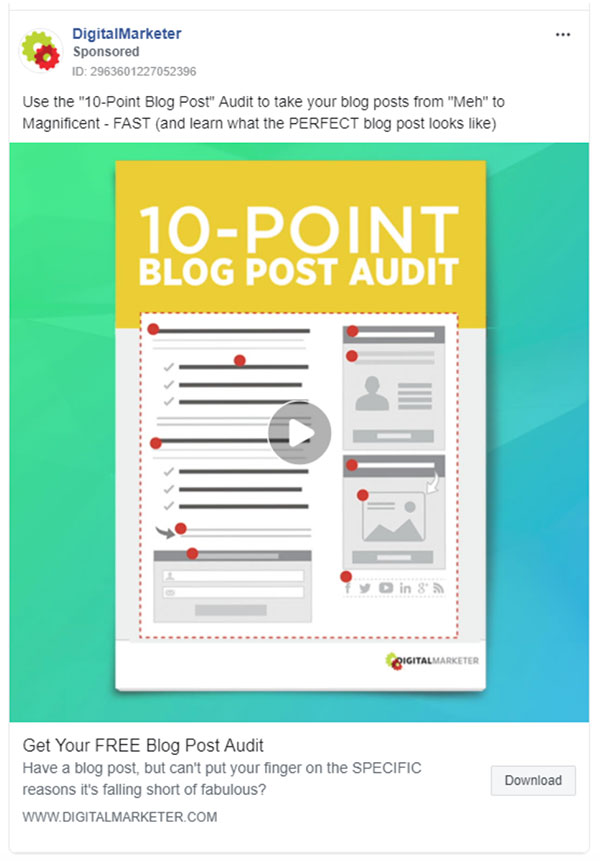
All you have to do is fill out a form to sign up for our email list, and you’ll get the Lead Magnet (in this case a 10-point blog post audit) free.
Convert
Now it’s time to get some sales. This stage of the CVJ is all about generating customers.
The mistake many companies make is trying to jump straight to Convert, and skipping the 3 steps that come before it.
But when you follow the CVJ in its proper order—by creating awareness, engagement, and subscription before asking for the sale—you’ll discover that people are much more likely to buy from you.
Here’s an example of a “Convert” ad by HelloFresh:

Notice how they’re trying to maximize their number of sales by presenting an irresistible offer (10 free meals). Yes, giving a discount cuts into profits, but it also generates more total customers.
And the more customers you have, the more profits you can earn later when you reach the next stage of the CVJ…
Ascend
Last but not least, the Ascend step is all about getting your customers to make more purchases and bigger purchases over time.
Running paid online ads to your customer base can be extremely profitable, because these people already know and trust you—which means they’re much more likely to buy higher-priced products.
Sea-Doo does a great job with this ad, in which they promote an extended warranty:

How Digital Advertising Fits in with Customer Value Optimization
We teach another system here at DigitalMarketer. This one provides a 10,000-foot view of how the marketing process works (when it’s done right).
We call it Customer Value Optimization.
Here’s what it looks like:

The Customer Value Optimization process gives you a tested and reliable roadmap to build an unstoppable business in any niche, market, or industry.
So where does digital advertising, AKA paid online media fit in?
At the very top, as one of the traffic sources that send people into this whole process in the first place:

The beauty of the Customer Value Optimization process is that you only have to pay for traffic at the beginning. Once a visitor has subscribed to your newsletter, you can continue to follow-up with them for free.
The Most Important Digital Advertising Platforms
OK, now you should have a pretty good idea of what digital advertising is, why it’s such an important part of your overall digital marketing strategy, and how it fits into the big picture.
Next, let’s dive into some of the specific platforms available.
Remember that the concept of paid advertising is nothing new. It’s just the channels, or mediums, that have changed with the rise of the internet.
You can actually think of many of these platforms as a newer “digital equivalent” of an older advertising medium. For example:
- Google is like the Yellow Pages
- Facebook is like a billboard
- Pandora is like radio
- YouTube is like TV
Depending on your industry, different platforms may make more (or less) sense for your business.
Here’s a brief overview of some of the biggest digital advertising platforms online today:
Facebook & Instagram
Facebook has grown to become one of the biggest and most valuable digital advertising platforms online today. We’re lumping it together with Instagram since both platforms are owned by Facebook and use the same ad platform (Ads Manager).
Facebook & Instagram are incredibly effective channels for paid ads. A big part of the reason why is because they have a lot of data on their users, which the Facebook algorithm uses to optimize ad delivery for the best results.
Here are some basic facts…
- 2.41 billion monthly active users
- Users by age range:
- 18–24: 76%
- 25–29: 84%
- 30–49: 79%
- 50–64: 68%
- 65+: 46%
- Users spend 38 minutes/day on the platform
- 74% of users log in daily
- 94% of Facebook’s ad revenue comes from mobile
- 1 billion monthly active users
- Users by age range:
- 18–29: 67%
- 30–49: 47%
- 50–64: 23%
- 65+: 8%
- Users spend 28 minutes/day on the platform
- 63% of users log in daily
- 73% of US teens say Instagram is the best way for brands to communicate about new products or promotions
Another great thing about Facebook & Instagram ads is that they support a wide range of formats, such as…
Image Ads

Video Ads

Carousel Ads

Instant Experience Ad (Mobile Only)
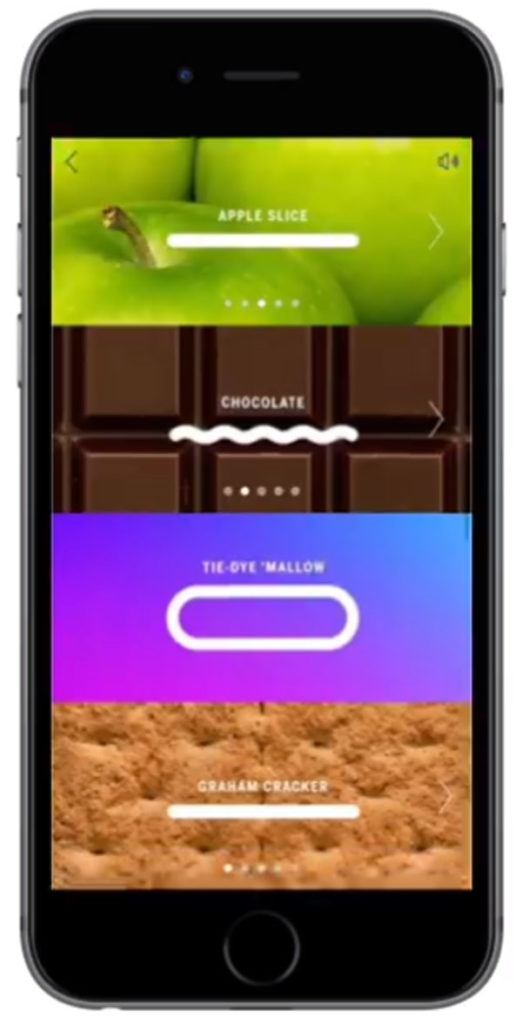
Shop-able Ads (Instagram Only)
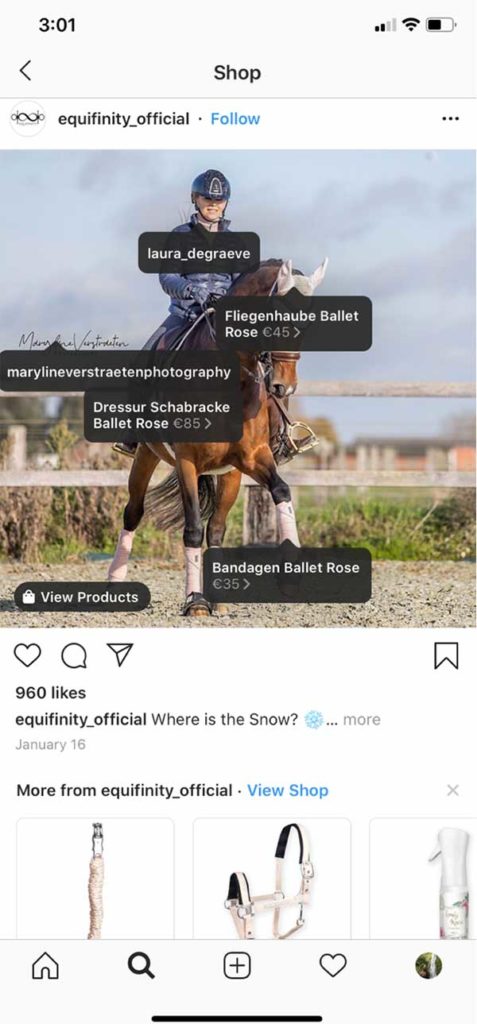
Facebook and Instagram are frequently testing and rolling out new ad types, which means you have a wide range of options for engaging people on these platforms.
Google Ads are separated into 2 different networks: the Google Search Network and the Google Display Network.
Google Search Ads appear on the SERPs (search engine results pages) when you search for certain keywords. For example, here are the ads that appeared after a search for “cat tree”:

The powerful thing about Google Search Ads is that they give you a way to get your ads in front of people as they’re actively searching for you (or a topic related to what you do).
Most ads on the Google Search Network are text-only ads, although Google has been adding support for newer ad types such as Shopping Ads. (The image above shows both Shopping Ads, at the top, with text ads below them.)
The Google Display Network (GDN) is different. On this platform, you can display your ads across more than 2+ million participating websites. GDN has a vast reach; according to ComScore, GDN ads have the potential to reach up to 94% of U.S. Internet users and 90% of global Internet users.
And unlike the Search Network, GDN supports a wide variety of banner ad, rich media ads, and even video ads.
Here’s an example of a banner ad that does a good job of delivering a solid promise and making a clear call-to-action.

YouTube
While YouTube is owned by Google and uses the same ads manager as Google Ads, we’re separating them here since they’re such different platforms.
YouTube is the video site. But it’s more than that: it’s one of the biggest search networks, and one of the biggest websites in general, in the world. And for marketers looking to reach new customers, it’s a goldmine of a digital advertising platform.
Here are some of the basic deets…
- 2 billion monthly logged-in users
- Users by age range:
- 15–25: 81%
- 26–35: 71%
- 36–45: 67%
- 46–55: 66%
- 56+: 58%
- Users spend 11 minutes/day on the platform
- Over 70% of YouTube views come from mobile
- 70% of what people watch on YouTube is determined by its recommendation algorithm
Like any other paid online media platform, YouTube offers a variety of ad formats and options. For instance:
TrueView In-Stream Ads are a form of video ad that plays before a viewer’s chosen video. The cool thing about TrueView ads is that you only pay when the viewer watches or interacts with your ad.

Video Discovery Ads are displayed on the YouTube homepage and search results pages (the concept is similar to Google Search Ads).

Bumper Ads are short (6 seconds), non-skippable video ads that play before a viewer’s chosen video.
Pre-roll Ads are longer non-skippable ads that play before a chosen video.
Video is a tremendously powerful way to reach new customers online. If you leverage video in your business, you probably want to be on YouTube.
Other Digital Advertising Platforms
While Facebook, Instagram, Google, and YouTube are the biggest online media platforms on the block, they’re by no means the only options.
Depending on your industry, these platforms might also be a good fit for your business:
Amazon
Amazon has become an important digital advertising platforms for ecommerce companies. A whopping 59% of consumers start their product searches here, which makes it a great place to buy traffic.
Amazon ads can show up in a variety of places, such as the search results:

Or the “Sponsored Products” section:

Pinterest Ads can be a great way to help users discover and buy your products. Ads appear as “Promoted Pins,” such as these 2 ads by Target and Casper:

People often use Pinterest to find new products, making this a valuable network for ecommerce companies. (Especially if you sell visual products that would lend themselves to a cool-looking picture.)
LinkedIn is a social network for professionals, which means it’s potentially an important source of traffic for B2B businesses and anyone targeting professionals.
They offer several types of ad formats, such as Sponsored Content, Text Ads, and Sponsored InMail.
Here’s an example with Sponsored Content (on the left) and Text Ads (on the right):

But the most important part of deciding where to run your ads is to know where your audience is most likely to be. If your ads are placed where your target audience is most likely to see them, you’ll get the best chance at conversion and the best ROI.
Ad Targeting
Choosing a digital advertising platform is just the first step. Once you’ve decided on where you want to run your ads, the next thing you’ll need to do is decide WHO you want to show your ads to.
We call that targeting.
Different networks have different options for targeting. For example:
- On the Google Search Network you have to choose which keywords you want your ads to appear for.
- On LinkedIn, you can target specific job titles.
- And on Facebook, you can show ads to people based on their interests.
Most ad platforms also allow you to further refine your targeting by demographics, giving you the ability to focus on (or exclude) people based on their age, gender, location, and so on.
There are 2 more concepts related to ad targeting that you’ll want to be familiar with. Those are traffic temperature and retargeting.
Traffic Temperature
When deciding whom to target with your ads, one decision you need to make is what traffic temperature to target.
If you’re targeting people who are already familiar with your brand and ready to buy, that’s considered hot or very warm traffic.
People who have never heard about you before, on the other hand, are considered cold traffic.
Why is the concept of warm and cold traffic useful?
Because it helps you to set the proper expectations and create your campaigns more strategically.
Any campaign targeting warm traffic is liable to convert at a higher rate and be more profitable—but the audience size is limited.
A campaign targeting cold traffic, on the other hand, has the potential to reach a much wider audience… but these campaigns also have a steeper hill to climb. In order to be successful, cold traffic ads may need to leverage different creative and/or messaging.
(NOTE: A good way to “warm up” cold traffic is to get them familiar with your brand. Running an ad to cold traffic that drives to content on your site can help with that.)
No matter what traffic temperature you’re targeting, there’s one digital advertising technique that is often highly effective. It’s called retargeting.
Retargeting
Retargeting is where you show your ads to someone who has already visited your website. (Or someone who has already engaged with your content on a platform like YouTube or Facebook.)
For example, say you visit the website for the call-tracking service CallRail:

When you visit the site, a cookie gets added to your browser that allows CallRail to show you ads on various online adverting platforms around the web—which explains why, when you visit Facebook, you may see a retargeting ad like this:

The great thing about retargeting is that you’re specifically targeting those people who have already demonstrated an interest in your product or service. As a result, these ads tend to perform quite well.
Creating Effective Ads
Another essential component of any online advertising is creating the actual ads that people see.
As you learned above in the section on The Most Important Digital Advertising Platforms, each platform’s ads look a little different. Some, like most Google Search Ads, are entirely text. Others, like Facebook Ads, can include images or video.
No matter what platform you’re advertising on, your goal is simple: you want to catch the user’s attention, stop them from scrolling, and get them to click on your ad.
To that end, here are some general principles to help make your ads more effective, since you don’t have to be a professional designer to design online ads.
Ad Design Tips
One way to make sure your ads stand out is to use bold colors and images. Like Waze does here:

Or like Drift does here:

When deciding on colors for your ads, here are a few things to keep in mind:
- Choose complementary or contrasting colors. Remember—your goal is to stand out.
- Avid dull blue on Facebook; it will blend in.
- If you don’t already have a color palette, try coolors.co. It will give you a combination of colors that look good together, like this:
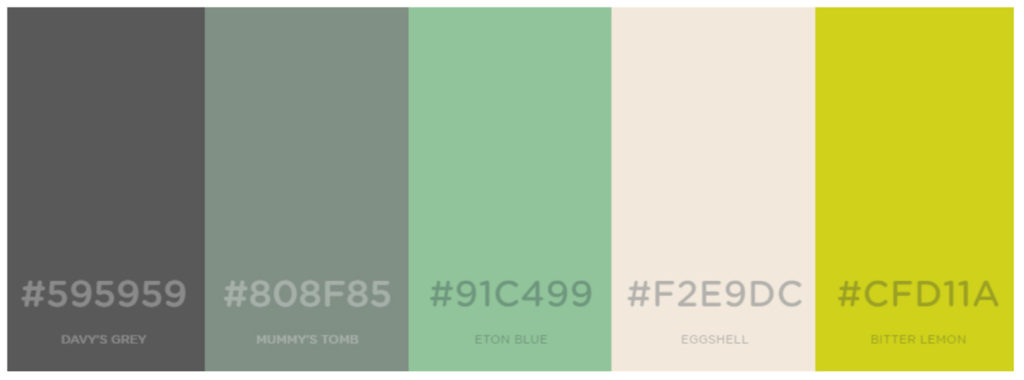
You may also want to consider using a consistent design across your ads. This can help reinforce your brand image and create a lasting impression.
See how Squarespace does it:
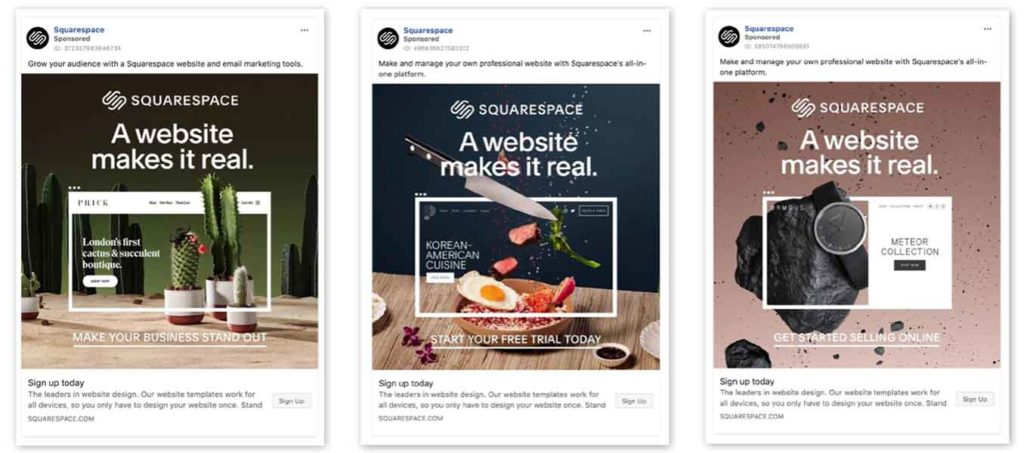
Here are a few final tips on ad design.
Font tips:
- Only use 1–2 fonts in an ad, never more than that
- Use only legible fonts
- Make sure you only use fonts that you have a commercial license for
Image tips:
- Always use high-quality images
- Decide if you want to primarily use illustrations or photography, then stick with it
- NEVER use images from just a Google image search; make sure you have the right copyright permissions to use them
Next, here are a few pointers on how to write effective copy for your ads.
How to Write a Good Ad Hook
Another important element of your ad is the copy (AKA the text) you use. Good ads have a compelling “hook,” a unique angle that speaks to your ideal prospects and makes them want to learn more and take the next step.
So how can you find a good hook for your ads?
One way is to use The Before & After Strategy to answer these questions:
- Have. What will your prospect HAVE if they buy your product or service?
- Feel. How will your prospect FEEL if they buy your product or service?
- Average Day. How will your prospect’s AVERAGE DAY improve if they buy your product or service?
- Status. How will your prospect’s STATUS become elevated after buying your product or service?
- Good vs. Evil. How will your product or service help your prospect to conquer EVIL and bring more GOOD into their world?
The answers to these questions will give you 5 solid hooks that will appeal to your target customers.
Many marketers never get past the first question. All they think about is what their product will help the prospect to HAVE, without thinking about how it will make them feel, improve their day, raise their status, or make the world a better place.
But when you dig deeper than surface benefits, you can uncover much more compelling ad hooks.
Chatbooks gets it:

See how this ad isn’t just talking about the thing you’ll have (a printed photo book)? Instead it speaks to the way you’ll feel (closer to your family) after buying their product.
Chatbooks understands that their avatar (busy moms) don’t really want a printed photo book. Instead, they want a close, loving family that appreciates their time together. And speaking to that desire makes for a much more compelling ad.
BONUS TIP: How to Find the Right Hook for Each of Your Customer Avatars
Eventually you’re going to reach the point where you have several different customer avatars, and multiple different ad hooks. And one thing you may be unclear about is:
How do you know which hooks to use for which avatars?
Lucky for you, we’ve run into this same problem—and we came up with a process to figure it out.
Here’s what you do:
Step 1 is to make sure you define your customer avatars. This is important to get clear on who you’re targeting with your ads.
Once you’ve done that…
Step 2 is to plug your avatars, and your hooks, into the The Ad Grid.
The Ad Grid is a process you can use to help organize your hooks & avatars and systematize the creation of your traffic campaigns.
This is the process that helped us to stop creating “one-hit wonder” ads and generate more consistent & predictable results from our campaigns.
The Importance of Your Landing Page
When your ad is complete, the last thing you’ll need to have ready before launching your campaign is your landing page.
Your landing page is simply the webpage that people are taken to after they click on your ad.
Choose this page with care. In most cases, your best bet is to create a page specifically made to be a perfect fit for your ad.
For example, here’s an ad from Air Canada:

And here’s the top of the landing page made specifically for that ad campaign:

Notice how the landing page matches the colors, images, and messages from the ad.
We call that ad scent.
In a nutshell, the idea behind ad scent is that when someone clicks on your ad, they expect to see the same offer on the next page. So give them what they expect to see.
(Otherwise, they might think they’ve come to the wrong place and leave.)
Here’s another example from Grasshopper. See how the ad and landing page share a similar look and feel? Anyone who clicks on that ad is going to immediately know that they’re in the right place on the next page.
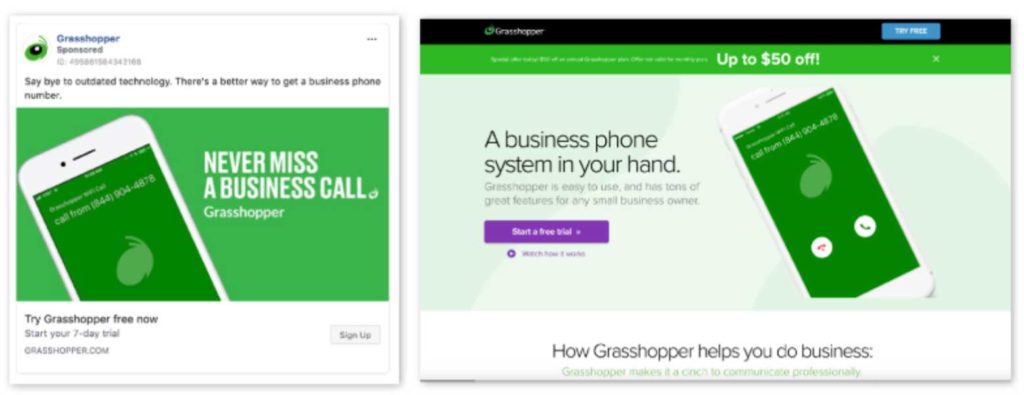
Another thing to keep in mind when creating and optimizing landing pages is that it’s best to keep them focused on a single call to action, without anything else on the page to distract from it.
For example, take a look at our landing page for the Facebook Ad Template Library:

Notice the entire page is focused on that one topic, and every call to action on the page promotes that one lead magnet.
Metrics to Help You Measure Your Digital Advertising Success
Once you launch an online advertising campaign, your next question is liable to be:
Are my ads actually working?
The answer isn’t always as straightforward as we’d like it to be.
Depending on the goals of your campaign, you might use a different combination of metrics to measure your success. Here are some of the most commonly used metrics to measure the success of digital advertising campaign—and to help pinpoint where things aren’t working so you can improve them.
- Revenue. How much money your ads generated.
- Return on Ad Spend (ROAS). Revenue divided by ad spend. For example, a ROAS of 3.4 means that for every $1 you spent on advertising, you earned $3.40 in revenue.
- Sales. The number of sales generated.
- Cost per sale. The average cost to generate a new sale.
- Leads. The number of leads generated.
- Cost per lead (CPL). The average cost to generate a new lead.
- Clickthru rate (CTR). The percentage of people who click on your ad.
- Cost per mille (CPM). This is the cost to reach 1,000 people. The lower your CPM, the cheaper it is to reach a wider audience.
- Cost per click (CPC). This is the amount you pay every time someone click on your ad.
(Note that an ad platform will charge you based on either impressions or clicks—CPM or CPC, respectively—but not both.)
If you’re going to be managing digital advertising campaigns, you’ll want to get familiar with these terms. Because you’ll see them a lot, and you’ll need to interpret them and use them to help improve the performance of your ads over time.
Speaking of improving your ads’ performance…
Optimizing Your Digital Advertising Campaigns
When you launch your first-ever online ad, you might expect the sales to start pouring in immediately.
Unfortunately, that’s usually NOT the case.
Instead, your results right out of the gate are liable to range anywhere from “decent” to “awful.”
But don’t be discouraged. The first time you played basketball, or went roller skating, or tried to crochet, you probably weren’t very good either.
Digital advertising is a skill, just like any other.
The good news is that every time you launch an online advertising campaign, you learn something new. Even if the ads don’t work, at the very least you’ve gained some valuable insight into what doesn’t work.
And now you can take that insight and use it to improve. Then try again. And repeat.
This process is called optimization. Basically, it just means making changes to your digital advertising campaigns to improve your results over time.
Some of the things you can change or tweak can include:
- New ads
- New targeting options
- New landing pages
- A new offer
- Different settings inside your advertising platform
That last bullet could refer to all sorts of different things, such as changing your bid prices or your optimization strategies. These kinds of changes can have a huge impact on how well your ads perform, so make sure you understand what you’re doing when you change a setting inside a digital advertising platform.
By carefully testing and tweaking all the elements inside your campaigns, over time you’ll start to learn what works—and what doesn’t—which you can use to improve your results more and more over time.
And when your campaigns do start to work, and you realize you’re getting a good return on your investment, what can you do to get even MORE of those good results?
That’s called scaling, and that’s what we’ll cover next.
Scaling Your Digital Advertising Campaigns
Scaling is what you do when your campaigns are working, and you want more of the same results.
Generally speaking, there are 2 ways to scale a campaign: vertically and horizontally.
Vertical scaling is when you increase the budget on your campaigns to reach more people.
For example: If you’re spending $50/day in Facebook and getting good results, you could increase your budget to $100/day to get even more results.
Horizontal scaling is when you take an ad that’s working for one audience and start showing it to new audiences.
For example: If you’re targeting people who like nutrition, you could try also targeting people who like healthy eating, Mediterranean diet, supplements, exercise, and so on.
Not every audience is going to work. Some may be too far from your target avatar to be effective. But you’ll never really know for sure until you try.
And as you’re scaling up your campaigns, here’s a word to the wise: keep an eye on your results to make sure you’re within an acceptable range.
If your CPL or CPA start to get too high, you can always put the scaling on hold, then go back and do some optimization.
Want to Learn Even More About Digital Advertising?
Then you’re in luck. Because here at DigitalMarketer, digital marketing is kinda… you know… what we do.
Here are some more awesome blog posts to help you master the ways of digital advertising so you can guide your business to new heights online:
When Should You Start Your Paid Traffic Campaign?
Crafting a Digital Advertising Strategy
[New Formula] WCA + YC = Cheap, High-Converting Traffic from Facebook
Facebook News Feed Changes: What You Need to Know
[DOWNLOAD] Score Your Paid Traffic with the 5-Point Paid Ad Audit
Breaking Down How Politicians Used Ads In 2019
13 Great Instagram Video Ad Examples
47 Facebook Ad Examples That You Can Swipe for Your Business
Retargeting Ads in 500 Words or Less (Plus 3 Bonus Retargeting Tips)
What is a Tracking Pixel—Explained in 800 Words or Less
The YouTube Ads Grid: A 3-Step System to Build YouTube Ads Campaigns that Generate More Leads & Sales
Chatbots Explained in 800 Words or Less
How to Design Facebook Ad Images Like a Pro (…When You’re Really an Amateur)
The 7-Step Facebook Ad Plan… Lessons Pulled from the DigitalMarketer Vault
[ad_2]
